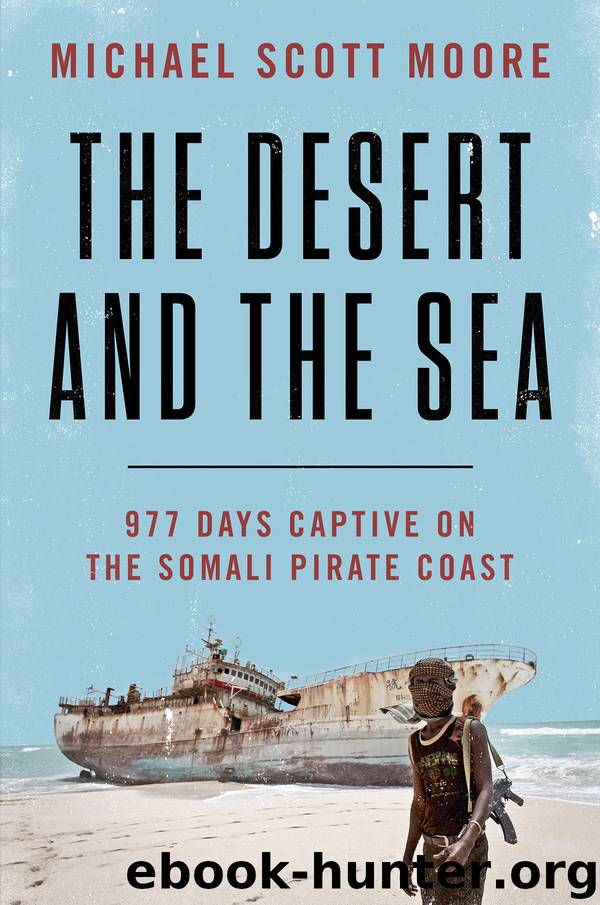The Desert and the Sea by Michael Scott Moore

Author:Michael Scott Moore
Language: eng
Format: epub
Publisher: HarperCollins
Published: 2018-07-23T16:00:00+00:00
XV
Somebody unearthed an antique meat grinder from the bowels of the ship, and Sosan set to work on a three-day project to clean and reassemble it. He let the parts soak in salt water and cleaning fluid. He scrubbed everything with steel wool. He cleaned it, again, in fresh water, but couldn’t decide where to use it. The bottom formed a vise clamp, for the edge of a table, so Taso found a beam of wood. Someone else found a wooden dowel for a handle, and soon the men were feeding carefully filleted sides of grouper into the greenish-copper machine.
The final result was a bowl of mashed fish, which Taso kneaded with flour. We formed the mixture into little rounds. The Cambodians cooked them in a sizzling wok. Then they were salted and left to dry, and soon everyone had fish cakes.
The strangest meal on the Naham 3, however, was also the simplest. Whenever the crew hauled a new tuna from the freezer and carved it up with the buzz saw, Tony made sure to keep aside a small brick of red meat. Before dinner the brick would be washed and defrosted, and by dinnertime Tony would carry out a tin platter of cold, sliced sashimi.
“Sashimi, okay!” said Korn Vanthy.
“Psycho-psycho,” said Sosan, meaning crazy good.
The Chinese had a bag of powdered wasabi mix, and they stirred up a batch of watery green sauce in a plastic bowl. The men were used to helping themselves to sashimi this way, now and then, from the frozen stock, as an indulgent treat from the captain. (“The captain ate raw fish a lot,” said Tony. “He was over sixty years old, but very strong!”) Everyone ate five or six slices on a hot pile of rice. Some slices were still half-frozen, but the fish tasted surprisingly fresh. Without thinking about it, I suppose, I had lived under the impression that “sushi grade” tuna in the West was somehow fresh—once frozen, maybe, but recently caught, within weeks or days. But sushi-grade fish may sit flash-frozen on a ship like the Naham 3 for many months. A “sushi grade” designation in the United States, in fact, requires a week of freezing to kill parasites.
One afternoon, a number of rainbow runners were lying on the deck, and I took a filleting lesson from Em Phumanny, the bowl-cut Cambodian with Buddhist tattoos. We planned to make kinilaw, a kind of Filipino ceviche made of cold, chopped, vinegary whitefish. “The fish is not cooked, you know?” said Tony. “It is cured in the vinegar.”
I squatted in the sun near the cutaway rail while the pirates watched us drowsily. Phumanny showed me how to start the cut. It was late morning. There would be no fresh khat for hours, and when I pulled the first fillet free and walked over to lay it on a plate, I heard an unnatural buzz from the north, to the rear of the ship. A light wind blew the sound away. It didn’t rouse the Somalis.
Download
This site does not store any files on its server. We only index and link to content provided by other sites. Please contact the content providers to delete copyright contents if any and email us, we'll remove relevant links or contents immediately.
| Anthropology | Archaeology |
| Philosophy | Politics & Government |
| Social Sciences | Sociology |
| Women's Studies |
The Secret History by Donna Tartt(18865)
The Social Justice Warrior Handbook by Lisa De Pasquale(12143)
Thirteen Reasons Why by Jay Asher(8802)
This Is How You Lose Her by Junot Diaz(6804)
Weapons of Math Destruction by Cathy O'Neil(6155)
Zero to One by Peter Thiel(5694)
Beartown by Fredrik Backman(5610)
The Myth of the Strong Leader by Archie Brown(5429)
The Fire Next Time by James Baldwin(5253)
How Democracies Die by Steven Levitsky & Daniel Ziblatt(5134)
Promise Me, Dad by Joe Biden(5090)
Stone's Rules by Roger Stone(5029)
A Higher Loyalty: Truth, Lies, and Leadership by James Comey(4852)
100 Deadly Skills by Clint Emerson(4845)
Rise and Kill First by Ronen Bergman(4706)
Secrecy World by Jake Bernstein(4653)
The David Icke Guide to the Global Conspiracy (and how to end it) by David Icke(4629)
The Farm by Tom Rob Smith(4443)
The Doomsday Machine by Daniel Ellsberg(4421)
